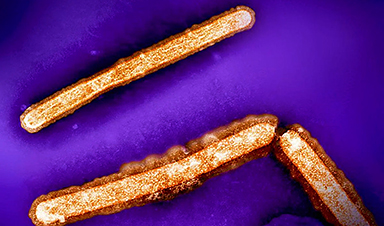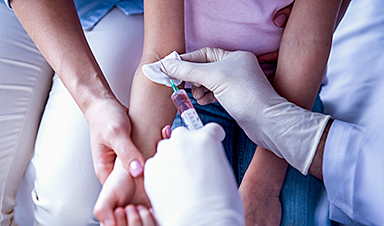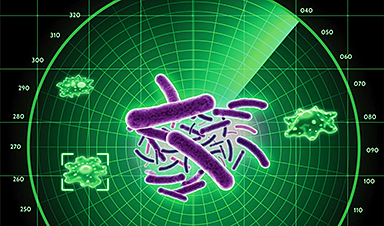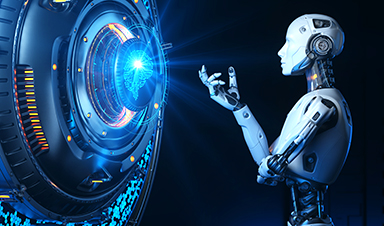NIH-funded study concludes that the risk of human infection remains low
A recent study published in Science and funded by the National Institutes of Health (NIH) has found that a single alteration in a protein on the surface of the highly pathogenic avian influenza (HPAI) H5N1 virus—currently present in U.S. dairy cows—could significantly increase its potential for human-to-human transmission.
These findings highlight the critical importance of ongoing surveillance and monitoring of HPAI H5N1 for genetic changes that might enhance its ability to spread among humans.
At present, the bovine (cow) H5N1 virus is not capable of human-to-human transmission. However, infections have been documented in individuals exposed to infected wild birds, poultry, dairy cows, and other mammals. As part of global pandemic preparedness efforts, researchers have long studied H5N1 to track natural genetic mutations and assess their potential impact on transmissibility.
Influenza viruses attach to cells with a surface viral protein called hemagglutinin (HA). The HA latches on to sugar (glycan) molecule receptors on cells to cause infection. Avian (bird) influenza viruses—like H5N1—have not infected people often because the human upper respiratory tract lacks the avian-type cell receptors found in birds. Scientists are concerned that viruses could evolve to recognize human-type cell receptors in the upper airways and acquire the ability to infect people and spread between them.
Laboratory Study on HA Protein Mutations
Scientists at Scripps Research used the H5N1 strain isolated from the first U.S. human infection with the bovine strain 2.3.4.4b (A/Texas/37/2024) to test how mutations in the HA gene sequence affected the binding of that protein with avian versus human-type cell receptors. The researchers introduced several mutations into the viral HA protein that had been observed to occur naturally in the past and found that one mutation, called Q226L, improved the ability of the protein to attach to receptors typically found on human cells, especially when an additional mutation was present. Importantly, the researchers introduced the genetic mutations only into the HA surface protein and did not create or conduct experiments with a whole, infectious virus.
The experimental finding with the Q226L mutation alone does not mean HPAI H5N1 is on the verge of causing a widespread pandemic, the authors note. Other genetic mutations would likely be required for the virus to be transmitted among people. In the setting of a growing number of H5N1 human cases resulting from direct contact with infected animals, the findings stress the importance of continued efforts at outbreak control and continued genomic surveillance to monitor for the emergence of HPAI H5N1 genetic changes and maintain public health preparedness.
Reference: “A single mutation in bovine influenza H5N1 hemagglutinin switches specificity to human receptors” by Ting-Hui Lin, Xueyong Zhu, Shengyang Wang, Ding Zhang, Ryan McBride, Wenli Yu, Simeon Babarinde, James C. Paulson and Ian A. Wilson, 5 December 2024, Science.
DOI: 10.1126/science.adt0180
The research was funded in part by NIH’s National Institute of Allergy and Infectious Diseases (NIAID), through its Centers of Excellence for Influenza Research and Response program.
News
Measles Is Back: Doctors Warn of Dangerous Surge Across the U.S.
Parents are encouraged to contact their pediatrician if their child has been exposed to measles or is showing symptoms. Pediatric infectious disease experts are emphasizing the critical importance of measles vaccination, as the highly [...]
AI at the Speed of Light: How Silicon Photonics Are Reinventing Hardware
A cutting-edge AI acceleration platform powered by light rather than electricity could revolutionize how AI is trained and deployed. Using photonic integrated circuits made from advanced III-V semiconductors, researchers have developed a system that vastly [...]
A Grain of Brain, 523 Million Synapses, Most Complicated Neuroscience Experiment Ever Attempted
A team of over 150 scientists has achieved what once seemed impossible: a complete wiring and activity map of a tiny section of a mammalian brain. This feat, part of the MICrONS Project, rivals [...]
The Secret “Radar” Bacteria Use To Outsmart Their Enemies
A chemical radar allows bacteria to sense and eliminate predators. Investigating how microorganisms communicate deepens our understanding of the complex ecological interactions that shape our environment is an area of key focus for the [...]
Psychologists explore ethical issues associated with human-AI relationships
It's becoming increasingly commonplace for people to develop intimate, long-term relationships with artificial intelligence (AI) technologies. At their extreme, people have "married" their AI companions in non-legally binding ceremonies, and at least two people [...]
When You Lose Weight, Where Does It Actually Go?
Most health professionals lack a clear understanding of how body fat is lost, often subscribing to misconceptions like fat converting to energy or muscle. The truth is, fat is actually broken down into carbon [...]
How Everyday Plastics Quietly Turn Into DNA-Damaging Nanoparticles
The same unique structure that makes plastic so versatile also makes it susceptible to breaking down into harmful micro- and nanoscale particles. The world is saturated with trillions of microscopic and nanoscopic plastic particles, some smaller [...]
AI Outperforms Physicians in Real-World Urgent Care Decisions, Study Finds
The study, conducted at the virtual urgent care clinic Cedars-Sinai Connect in LA, compared recommendations given in about 500 visits of adult patients with relatively common symptoms – respiratory, urinary, eye, vaginal and dental. [...]
Challenging the Big Bang: A Multi-Singularity Origin for the Universe
In a study published in the journal Classical and Quantum Gravity, Dr. Richard Lieu, a physics professor at The University of Alabama in Huntsville (UAH), which is a part of The University of Alabama System, suggests that [...]
New drug restores vision by regenerating retinal nerves
Vision is one of the most crucial human senses, yet over 300 million people worldwide are at risk of vision loss due to various retinal diseases. While recent advancements in retinal disease treatments have [...]
Shingles vaccine cuts dementia risk by 20%, new study shows
A shingles shot may do more than prevent rash — it could help shield the aging brain from dementia, according to a landmark study using real-world data from the UK. A routine vaccine could [...]
AI Predicts Sudden Cardiac Arrest Days Before It Strikes
AI can now predict deadly heart arrhythmias up to two weeks in advance, potentially transforming cardiac care. Artificial intelligence could play a key role in preventing many cases of sudden cardiac death, according to [...]
NanoApps Medical is a Top 20 Feedspot Nanotech Blog
There is an ocean of Nanotechnology news published every day. Feedspot saves us a lot of time and we recommend it. We have been using it since 2018. Feedspot is a freemium online RSS [...]
This Startup Says It Can Clean Your Blood of Microplastics
This is a non-exhaustive list of places microplastics have been found: Mount Everest, the Mariana Trench, Antarctic snow, clouds, plankton, turtles, whales, cattle, birds, tap water, beer, salt, human placentas, semen, breast milk, feces, testicles, [...]
New Blood Test Detects Alzheimer’s and Tracks Its Progression With 92% Accuracy
The new test could help identify which patients are most likely to benefit from new Alzheimer’s drugs. A newly developed blood test for Alzheimer’s disease not only helps confirm the presence of the condition but also [...]
The CDC buried a measles forecast that stressed the need for vaccinations
This story was originally published on ProPublica, a nonprofit newsroom that investigates abuses of power. Sign up to receive our biggest stories as soon as they’re published. ProPublica — Leaders at the Centers for Disease Control and Prevention [...]





















